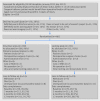Percutaneous fixation with Kirschner wires versus volar locking plate fixation in adults with dorsally displaced fracture of distal radius: randomised controlled trial
- PMID: 25096595
- PMCID: PMC4122170
- DOI: 10.1136/bmj.g4807
Percutaneous fixation with Kirschner wires versus volar locking plate fixation in adults with dorsally displaced fracture of distal radius: randomised controlled trial
Abstract
Objectives: To compare the clinical effectiveness of Kirschner wire fixation with locking plate fixation for patients with a dorsally displaced fracture of the distal radius.
Design: A multicentre two arm parallel group assessor blind randomised controlled trial with 1:1 treatment allocation.
Setting: 18 trauma centres in the United Kingdom.
Participants: 461 adults with a dorsally displaced fracture of the distal radius within 3 cm of the radiocarpal joint that required surgical fixation. Patients were excluded if the surgeon thought that the surface of the wrist joint was so badly displaced it required open reduction.
Interventions: Kirschner wire fixation: wires are passed through the skin over the dorsal aspect of the distal radius and into the bone to hold the fracture in the correct anatomical position. Locking plate fixation: a locking plate is applied through an incision over the volar (palm) aspect of the wrist and secured to the bone with fixed angle locking screws.
Primary outcome measure: validated patient rated wrist evaluation (PRWE). This rates wrist function in two (equally weighted) sections concerning the patient's experience of pain and disability to give a score out of 100.
Secondary outcomes: disabilities of arm, shoulder, and hand (DASH) score, the EuroQol (EQ-5D), and complications related to the surgery.
Results: The baseline characteristics of the two groups were well balanced, and over 90% of patients completed follow-up. The wrist function of both groups of patients improved by 12 months. There was no clinically relevant difference in the patient rated wrist score at three, six, or 12 months (difference in favour of the plate group was -1.3, 95% confidence interval -4.5 to 1.8; P=0.40). Nor was there a clinically relevant difference in health related quality of life or the number of complications in each group.
Conclusions: Contrary to the existing literature, and against the rapidly increasing use of locking plate fixation, this trial found no difference in functional outcome in patients with dorsally displaced fractures of the distal radius treated with Kirschner wires or volar locking plates. Kirschner wire fixation, however, is cheaper and quicker to perform.
Trial registration: Current Controlled Trials ISCRTN 31379280. UKCRN 8956.
© Costa et al 2014.
Conflict of interest statement
Competing interests: All authors have completed the Unified Competing Interest form at
Figures


Comment in
-
Evidence-based hand and upper extremity surgery.J Hand Surg Am. 2015 Jun;40(6):1260-3. doi: 10.1016/j.jhsa.2015.04.006. J Hand Surg Am. 2015. PMID: 26004202 No abstract available.
References
-
- Barrett JA, Baron JA, Karagas MR, Beach ML. Fracture risk in the US Medicare population. J Clin Epidemiol 1999;52:243-9. - PubMed
-
- Chen NC, Jupiter JB. Management of distal radial fractures. J Bone Joint Surg Am 2007;89:2051-62. - PubMed
-
- Kakarlapudi TK, Santini A, Shahane SA, Douglas D. The cost of treatment of distal radial fractures. Injury 2000;31:229-32. - PubMed
-
- Downing ND, Karantana A. A revolution in the management of fractures of the distal radius? J Bone Joint Surg Br 2008;90:1271-5. - PubMed
Publication types
MeSH terms
Substances
Grants and funding
LinkOut - more resources
Full Text Sources
Other Literature Sources
Medical
